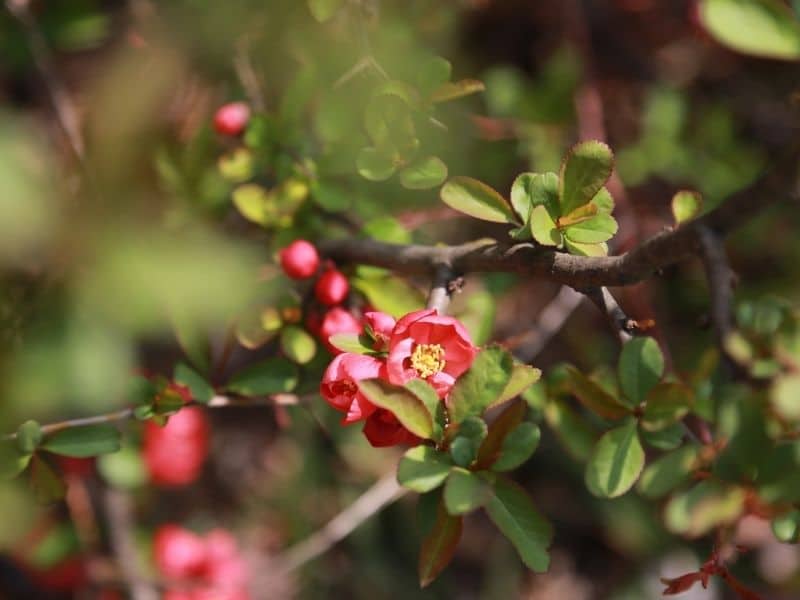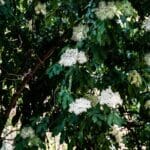The flowering quince is a useful deciduous shrub that puts on a beautiful show very early in the season each year. This plant’s tolerance for cold climates, ease of growth, and versatility make it a plant worth considering for any garden in zones 4-9. Read on to learn more about how to grow and care for the flowering quince.
What Is A Flowering Quince
The flowering quince (Chaenomeles speciosa) is a deciduous shrub of the Rose family (Rosaceae). These plants, which are also sometimes referred to as the common flowering quince, have multiple stems and take on a rounded growth form.
These thorny shrubs are native to China and reach a maximum size of around 10ft (3m) tall and wide. The simple and alternately arranged dark-green glossy leaves of this plant grow up to about 3 inches (7.5cm) long, have serrated margins, and grow on grayish brown stems.
Flowering Quince Flowers

These plants produce flowers on bare wood in the early spring or even late winter, putting on quite a showy floral display often before the season’s new leaves are produced. These plants may also flower in the fall, although not as profusely as in the early spring.
They can be single or double flowers, and they can be scarlet, red, pink, or white. The flowers, which are produced singly, measure up to about 2 inches (5cm) long. Typically, each flower has 5 petals, although varieties have been developed to produce flowers with as many as 40 petals. (1)
The flowers last up to about 2 weeks before the blossoms begin maturing into rounded speckled yellow-green fruits (pomes) of around 2.5 inches (6.5cm) long and wide.
Similar Species
The Chinese quince (C. cathayensis) grows to about the same size as C. speciosa but produces white to rich pink flowers and larger fruits. This species can be grown in zones 4-8.
The Japanese quince (C. japonica) is a similar species that doesn’t grow quite as large. These plants typically reach around 3ft (0.9m) in height and 6ft (1.8m) across. This quince plant produces red to orange flowers of about 1.5 inches (4cm) across and can be grown in much the same way as C. speciosa.

How To Grow A Flowering Quince
The fastest way of propagating large new plants is through the preparation of hardwood cuttings. These stem cuttings should be taken in the late fall to winter and will root after about a month. Root hormone powder works well to stimulate root growth on cuttings. Plants grown in this way will become sizable after 2 to 3 years. (1)
These chaenomeles speciosa plants can also be grown from seeds collected from ripe fruits. These seeds can be sown in the spring after being kept cold over the winter, or typically planted fresh in the fall.
This plant does best when grown in acidic, loamy, and well drained soil. Amending poor soils with compost will improve plant growth and vigor.
These flowering quince shrubs have moderate water requirements. Mulching will help keep the soil moist and will be helpful for young plants that need to be kept watered until established. Water these plants at soil level to keep the foliage dry and healthy.
Flowering quince shrub grows best in full sun to partial shade but generally flowers better in stronger light. Plants grown in warmer areas with stronger light will do better in limited light than plants grown in colder, more temperate climates. These plants are tolerant of a wide variety of temperatures, provided they are protected from strong winds and can be successfully grown in zones 4-9.

How to care for Flowering Quince
These low-maintenance shrubs do require annual pruning as they can develop a tangled and untidy look if left to grow into their natural form. Pruning will encourage a neater, more upright growth form. The plant will spread slowly by suckers which can be removed. Prune this shrub in the spring after bloom season or later in the season after fruit production if you wish to harvest these attractive pomes.
Pruning these plants also stimulates the production of more flowering spurs for the following flowering season. The quince bush often does not take well to frequent severe pruning and renovations should be made gradually, over a period of 2 or 3 years for best results.
These plants are fairly resistant to diseases and pests, although the plant may play host to aphids, scales, and mites. Diseases such as fungal leaf spot and occasional fireblight may affect the plant, and chlorosis may occur if these flowering quinces are grown in alkaline soils.
Uses
Horticultural uses
The thorny nature of this plant can be looked at as a real asset and these plants make fantastic security hedges or barriers against unwanted animal traffic. By the same token, growers should avoid growing this plant in high traffic areas where people are likely to brush against it.
This multi stemmed deciduous shrub also looks great as a border or even an espalier plant. For those with patience, the flowering quince tree makes a great subject for bonsai, and cut flowers look wonderful when displayed in vases.
Human uses
While not as tasty as the actual quince fruits, the edible fruits of this plant can be used to make jams, jellies, and preserves. In China, the plant has traditionally been grown as a medicine plant, windbreak, and erosion control. (3)
Wildlife uses
The flowers of quince bush are much enjoyed by pollinators like hummingbirds and butterflies. Unfortunately, the dark green foliage of this shrub is also enjoyed by hungry deer and rabbits.
FAQs
Should flowering quince be pruned?
Yes, flowering quince (Chaenomeles) can benefit from pruning. Regular pruning helps shape the plant, remove dead or diseased wood, and encourage better flowering. Prune after the blooming period, typically in late spring.
Where is the best place to plant flowering quince?
Choose a well-drained location with full sun to part shade for planting flowering quince. Good air circulation is also beneficial for preventing diseases.
Why is my flowering quince not blooming?
Flowering quince may not bloom due to factors like insufficient sunlight, late pruning (removing buds), or being too young. Ensure proper care, including adequate sunlight and appropriate pruning, to encourage blooming.
What is the best fertilizer for flowering quince?
Flowering quince generally does well in average soils but can benefit from a balanced fertilizer in early spring. Use a slow-release fertilizer with a balanced NPK ratio or one specifically formulated for flowering shrubs. Avoid excessive nitrogen, as it may encourage foliage growth at the expense of flowering.
What is the difference between quince and flowering quince?
Quince (Cydonia oblonga) and flowering quince (Chaenomeles) are related but distinct plants. Quince is primarily grown for its fruit, while flowering quince is cultivated for its ornamental flowers and is often smaller in size.
What does the flowering quince symbolize?
Flowering quince is often associated with symbols such as love, passion, and new beginnings. Its vibrant and early blooms make it a herald of spring, symbolizing renewal and the beauty of new life.
Conclusion
The flowering quince is a beautiful and hardy deciduous shrub that can be grown down to USDA hardiness zone 4. The thorny nature of this plant makes for a great security hedge, but flowering quince care should be taken when growing it in areas of the garden that get a lot of traffic.
References
References
(1) Frett, J. Early Spring Color To Warm Your Soul.
https://cdn.canr.udel.edu/wp-content/uploads/sites/16/2018/04/12024402/2013_Flowering_Quince_Chaenomeles-Feature.pdf
(2) Toogood, A. Plant Propagation: The Fully Illustrated Plant-By-Plant Manual Of Practical Techniques.
(3) Yang, L., Ahmed, S., Stepp, J. R., Zhao, y., Zeng, M. J., Pei, S., Xue, D. & Xu, G. Cultural Uses, Ecosystem Services, and Nutrient Profile of Flowering Quince (Chaenomeles speciosa) in the Highlands of Western Yunnan, China.
https://scholarworks.montana.edu/xmlui/bitstream/handle/1/15183/Ahmed_EB_2015_final.pdf;jsessionid=17996F2990C795B396DDD3873E5F3F4A?sequence=1
Close
*photo by flowering quince/depositphotos







